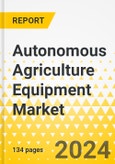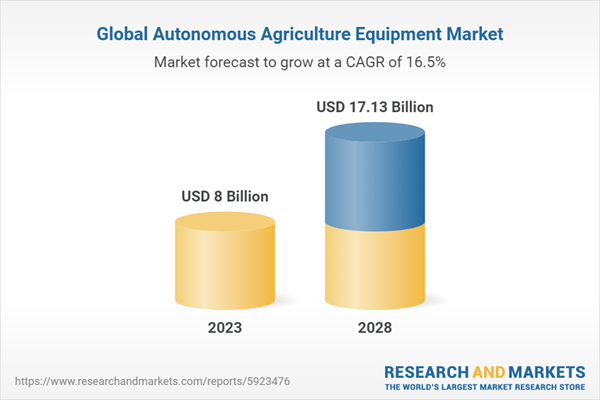10% Free customization
Introduction to the Autonomous Agriculture Equipment Market This report comes with 10% free customization, enabling you to add data that meets your specific business needs.
In recent years, the agricultural landscape has witnessed a transformative evolution with the advent of cutting-edge technologies, prominently exemplified by the rise of autonomous agriculture equipment. The convergence of robotics and farming, marked by terms such as autonomous agriculture, agriculture robots, and robotic farming, has given rise to a new era in agricultural practices. This innovative approach to farming leverages advanced technologies to create autonomous farms where tasks traditionally performed by human hands are now executed by sophisticated machinery.
At the heart of this agricultural revolution lie autonomous tractors, often referred to as driverless tractors or robot tractors. These autonomous behemoths are equipped with state-of-the-art sensors, artificial intelligence algorithms, and precision control systems that enable them to operate with unparalleled efficiency and accuracy. The fusion of autonomous technology with agriculture has not only streamlined traditional farming practices but has also paved the way for the development of a diverse range of autonomous farm equipment, including autonomous agriculture robots designed to perform a myriad of tasks across the cultivation cycle. As this report deep-dives into the realm of autonomous agriculture, it becomes imperative to explore the burgeoning autonomous agriculture equipment market. The market size and forecast for this industry provide insights into the growing significance of autonomous farming solutions. Analyzing the autonomous agriculture equipment industry unveils trends that showcase the continuous innovation and adaptation occurring in this field. From autonomous tractors in agriculture to robotic farming systems, the industry is witnessing a dynamic shift toward sustainable, efficient, and technologically advanced farming practices.
In 2022, the global autonomous agriculture equipment market reached a valuation of $5.81 billion. Over the forecast period 2023-2028, the market is projected to exhibit a CAGR of 16.45%, ultimately reaching a value of $17.13 billion by 2028.
Market Segmentation:
Segmentation 1: by Application
- Weeding
- Harvesting
- Spraying
- Others
Segmentation 2: by Product Type
- Self-Propelled Equipment
- Tractors
- Unmanned Aerial Vehicles (UAVs)
- Robots
- Multi-Functional
- Implements
Segmentation 3: by Region
- North America - U.S., Canada, Mexico
- Europe - Germany, France, Turkey, Greece, Netherlands, Belgium, Switzerland, Bulgaria, Ukraine, and Rest-of-Europe
- China
- U.K.
- Asia-Pacific - Japan, India, Australia, South Korea, and Rest-of-Asia-Pacific
- South America - Argentina, Brazil, and Rest-of-South America
- Middle East and Africa - South Africa, Israel, and Rest-of-Middle East and Africa
Recent Developments in the Global Autonomous Agriculture Equipment Market
- In February 2022, Naio Technologies unveiled the Orio straddle robot. The machine is an independent weeding robot. A wide variety of crops, including row crops, bed vegetables, and arable crops such as potatoes and beets, benefit from the use of Orio.
- In October 2020, AGCO Corporation introduced the Fendt Xaver robot, which has a seed unit for precise planting and an embedded seed-sowing system. The VarioGuide Lane guidance system on the robot allows for centimeter-accurate control of the machine.
- In April 2019, CNH Industrial N.V. partnered with AGCO Corporation, Bayer, Jacto, Nokia, Solinftec, TIM, and Trimble. This initiative would enable rural producers to fully benefit from today's precision farming and digital and automated technological resources while gaining access to a full range of new products and services enabled by connectivity, resulting in business optimization.
- In January 2021, YTO Group Corporation launched the world's first 5G driverless tractor. The tractor was invented in collaboration with Luoyang Research Institute for Intelligent Agricultural Equipment Co., Ltd. It has the potential to significantly change the world's agricultural industry with its self-driving mode, 5G technology, and clean energy (lithium battery).
Demand - Drivers, Challenges, and Opportunities
Market Drivers: Need for Sustainable Agricultural Operations
The challenges associated with natural resources, water availability, and soil degradation have incentivized manufacturers to delve into advanced and sustainable technologies in agriculture. Major players in the agricultural machinery sector have advocated at the United Nations Food System Summit for measures aimed at boosting production efficiency. Furthermore, government initiatives are positioned to support the adoption of sustainable farming equipment. Agriculture occupies a central position in the priorities of numerous countries and governments, serving as the backbone for various industries. Consequently, the exploration of autonomous agriculture, including autonomous farm equipment, robotic farming, and autonomous tractors, is considered a prudent course of action.This exploration aligns with the keywords such as autonomous agriculture, agriculture robot, autonomous farm, robotic farming, autonomous farm equipment, autonomous tractor, robot tractors, driverless tractor, autonomous agriculture robot, autonomous farming robot, autonomous tractors in agriculture, autonomous farming, robotic farming, and robotic agriculture. Additionally, it intersects with discussions surrounding the autonomous agriculture equipment market size and forecast, the autonomous agriculture equipment industry, and autonomous agriculture equipment market trends.
Market Challenges: Lack of Interoperability and Standardization
Ensuring interoperability is essential for farmers to seamlessly integrate various autonomous components into their operations, minimizing compatibility issues. Standardization encompasses the establishment of common protocols, communication standards, and data formats, enabling effective communication among diverse autonomous systems. Overcoming challenges related to the interoperability and standardization of autonomous agriculture equipment necessitates collaborative efforts from industry stakeholders, including manufacturers, policymakers, and technology developers. This collaboration aims to define and implement shared standards and protocols that foster interoperability, thereby augmenting the overall efficiency of autonomous agriculture equipment. This is particularly pertinent in the context of the autonomous agriculture equipment market, where trends and forecasts indicate the growing significance of autonomous farm equipment, such as autonomous tractors and robotics, in transforming the landscape of agricultural practices.Market Opportunities: Advancements in Agricultural Innovations
By collecting and analyzing data, farmers can significantly improve crop yields and overall efficiency by strategically configuring and placing seeds in the field. Autonomous agriculture is increasingly making its mark in this domain with the adoption of technologies such as autonomous farm equipment, robotic farming, and autonomous tractors. These innovations, including GPS-guided equipment and advanced data analytics, play a pivotal role in prescriptive planting strategies, tailoring approaches based on the unique characteristics of different areas within a field. The autonomous agriculture sector encompasses a range of advancements, from autonomous tractors to robotic farming systems. The market size and forecast for autonomous agriculture equipment, along with industry trends, highlight the significant growth and evolution of this field. The deployment of autonomous agriculture robots and driverless tractors underscores the ongoing transformation in agricultural practices, with a focus on enhancing efficiency, productivity, and sustainability.How can this report add value to an organization?
Product/Innovation Strategy: In the realm of autonomous agriculture equipment, technological advancements are transforming agricultural landscapes. Autonomous agriculture equipment utilizes diverse technologies such as robots, drones, and data analytics. These tools offer precise insights into crop health, optimizing irrigation, pest management, and harvest times. Innovations such as satellite imaging and remote sensing provide a holistic view of fields, empowering farmers to make informed decisions. The market encompasses a range of solutions, from real-time monitoring platforms to AI-driven predictive analysis, enabling farmers to enhance productivity and reduce resource wastage significantly.Growth/Marketing Strategy: The autonomous agriculture equipment market has witnessed remarkable growth strategies by key players. Business expansions, collaborations, and partnerships have been pivotal. Companies are venturing into global markets, forging alliances, and engaging in research collaborations to enhance their technological prowess. Collaborative efforts between tech companies and agricultural experts are driving the development of cutting-edge monitoring tools. Additionally, strategic joint ventures are fostering the integration of diverse expertise, amplifying the market presence of these solutions. This collaborative approach is instrumental in developing comprehensive, user-friendly, and efficient autonomous agriculture equipment.
Competitive Strategy: In the competitive landscape of autonomous agriculture, equipment manufacturers are diversifying their product portfolios to cover various crops and farming practices. Competitive benchmarking illuminates the strengths of market players, emphasizing their unique offerings and regional strengths. Partnerships with research institutions and agricultural organizations are driving innovation.
Methodology
Key Considerations and Assumptions in Market Engineering and Validation
- The scope of this report focuses on various types of autonomous agriculture equipment.
- The market revenue has been calculated based on global autonomous agriculture equipment manufacturing companies.
- The base currency considered for the market analysis is US$. Currencies other than the US$ have been converted to the US$ for all statistical calculations, considering the average conversion rate for that particular year.
- The currency conversion rate has been taken from the historical exchange rate of the Oanda website.
- Nearly all the recent developments from January 2020 to December 2023 have been considered in this research study.
- The information rendered in the report is a result of in-depth primary interviews, surveys, and secondary analysis.
- Where relevant information was not available, proxy indicators and extrapolation have been employed.
- Any future economic downturn has not been considered for the market estimation and forecast.
- Technologies currently used are expected to persist through the forecast with no major technological breakthroughs.
Primary Research
The primary sources involve autonomous agriculture equipment and agriculture industry experts and stakeholders such as data suppliers, platform developers, and service providers. Respondents such as vice presidents, CEOs, marketing directors, and technology and innovation directors have been interviewed to verify this research study's qualitative and quantitative aspects.The key data points taken from primary sources include:
- validation and triangulation of all the numbers and graphs
- validation of reports segmentation and key qualitative findings
- understanding the competitive landscape
- validation of the numbers of various markets for market type
- percentage split of individual markets for region-wise analysis
Secondary Research
This research study involves the usage of extensive secondary research, directories, company websites, and annual reports. It also makes use of databases, such as Hoovers, Bloomberg, Businessweek, and Factiva, to collect useful and effective information for an extensive, technical, market-oriented, and commercial study of the global market. In addition to the data sources, the study has been undertaken with the help of other data sources and websites.Secondary research was done to obtain crucial information about the industry’s value chain, revenue models, the market’s monetary chain, the total pool of key players, and the current and potential use cases and applications.
Key Market Players and Competition Synopsis
The featured companies have been meticulously chosen, drawing insights from primary experts and thorough evaluations of company coverage, product offerings, and market presence.Among the prominent players in the global autonomous agriculture equipment market, private ventures and innovative startups dominate, commanding approximately 64% of the market share in 2022. The remaining 36% is held by public enterprises.
Some prominent names established in this market are:
Company Type 1: Public Companies
- AGCO Corporation
- Deere & Company
Company Type 2: Private Companies
- Naïo Technologies
- Monarch Tractor
- Garuda Aerospace
- Koppert Machines & Zonen BV
- Harvest CROO Robotics LLC
This product will be delivered within 3-5 business days.
Table of Contents
1 Markets
2 Application
3 Product
4 Regions
5 Markets - Competitive Benchmarking & Company Profiles
6 Research Methodology
List of Figures
List of Tables
Companies Mentioned
- Naïo Technologies
- Deere & Company
- AGCO Corporation
- Monarch Tractor
- DJI
- Garuda Aerospace
- Koppert Machines & Zonen BV
- Harvest CROO Robotics LLC
- HORSCH
- YANMAR HOLDINGS CO., LTD.
- Ecorobotix SA
- Carbon Robotics
Table Information
| Report Attribute | Details |
|---|---|
| No. of Pages | 134 |
| Published | January 2024 |
| Forecast Period | 2023 - 2028 |
| Estimated Market Value ( USD | $ 8 Billion |
| Forecasted Market Value ( USD | $ 17.13 Billion |
| Compound Annual Growth Rate | 16.4% |
| Regions Covered | Global |
| No. of Companies Mentioned | 12 |









